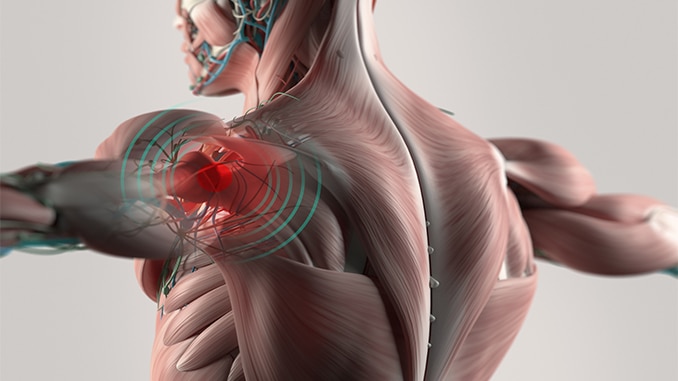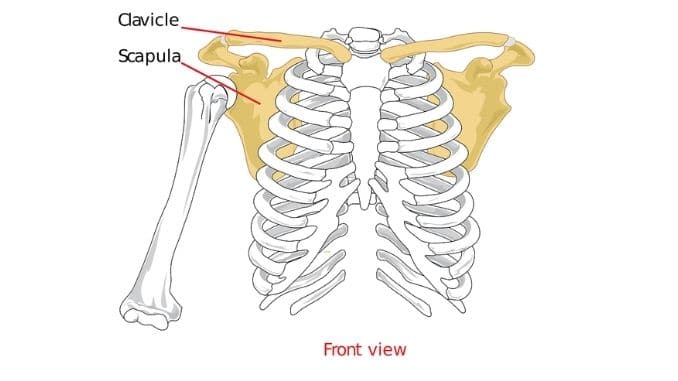
Shoulder pain is a common problem among adults, affecting from 4 to 26 percent of Americans. Most of the time, the pain comes from muscle tightness and knots, joint wear and tear, or rotator cuff issues. But in a small subset of cases, the cause is frozen shoulder [1], which occurs most often in people between the ages of 40 and 60.
CLICK HERE to watch the YouTube video.
Also known as adhesive capsulitis, frozen shoulder causes stiffness and pain in the shoulder joint and can make everyday tasks like getting dressed or retrieving something from an overhead shelf nearly impossible. Without treatment, it often gets worse, and recovery can take months or even years.
All of that pales, however, in comparison with cancer. For years, we would have never connected the two, but recent research has changed that. Some scientists have found an association between frozen shoulder and cancer.
Here’s what you need to know, and why if you do have a frozen shoulder, you shouldn’t panic. There are treatments available, and your risk of cancer — if it does exist — is low. Continue reading to know if frozen shoulder can put you at risk for cancer.
What Is Frozen Shoulder?
Frozen shoulder is so named because it causes the shoulder to stiffen, reducing its mobility and making it feel like it’s frozen in place. Doctors don’t know exactly what causes it, but they know that when it occurs, it is often the result of a problem in the joint capsule.
Fractures and overuse injuries like bursitis and tendinitis can lead to inflammation and a thickening of the connective tissues around the main shoulder joint. These tissues and tendons from the “joint capsule” that surrounds the joint and, as they become inflamed and scarred, they get stiff and lose their capacity to stretch.
This results in pain that, in turn, makes the patient less likely to move the shoulder. However, the lack of movement only makes the situation worse, further contracting the tissues. As the capsule tightens and shrinks, the shoulder joint has less room to move in, and the lubricating synovial fluid inside the joint capsule can become depleted.
Without treatment, bands of scar tissue form between the joint capsule and the bone, further limiting movement. The condition takes time to develop, with stiffness and range of motion gradually becoming worse over a period of three stages:
- Freezing stage: Movement in the shoulder causes pain. To avoid the pain, you limit movement, which contributes to the problem.
- Frozen stage: Pain may diminish during this time, but the shoulder becomes stiffer and movement more difficult.
- Thawing stage: After a long period, often years, the tissues, ligaments, and muscles relax gradually, and range of motion improves.
The following factors increase the risk of experiencing frozen shoulder:
- Suffering an injury to the shoulder, such as a rotator cuff injury, repetitive use injury, or broken arm.
- Suffering a stroke.
- Going through surgery, after which you don’t move your shoulder for a time.
- Diseases like diabetes, thyroid conditions, cardiovascular disease, and Parkinson’s disease.
Does Frozen Shoulder Increase Your Risk of Getting Cancer?

Research has recently suggested [2] that a frozen shoulder might be a complication or a symptom of cancer in some cases.
In 2005, for example, a group of doctors shared their experiences with five patients who were referred to their institution following prolonged, ineffective treatment for frozen shoulder. All five ended up having shoulder cancer instead.
The researchers noted that shoulder tumors are uncommon causes of shoulder pain and restricted movement but that, in those who do have cancer, misdiagnosis, inappropriate surgery, and delayed therapy, “may potentially have grave consequences.”
Further Studies Reveal Possible Connection

For a later 2010 study, researchers examined the clinical records of 34 patients [3] with malignant shoulder tumors and 505 patients with shoulder pain and stiffness. They found that among the 34 tumor patients, nine (26 percent) had been misdiagnosed initially with frozen shoulder syndrome. Another two also experienced shoulder pain and stiffness before their diagnosis of cancer.
Among the 505 patients with shoulder pain and stiffness, four (0.8 percent) were later diagnosed as having malignant tumors. One of those four had been initially misdiagnosed with frozen shoulder syndrome.
Altogether, in 10 of the patients, an initial misdiagnosis of frozen shoulder syndrome caused a significant delay in reaching the correct diagnosis and in administering treatment. The researchers suggested that doctors carefully re-examine frozen shoulder patients with imaging tests to check for cancer.
In a more recent 2017 study, researchers noted that frozen shoulder could be a complication or symptom of cancer. They examined data from more than 29,000 patients with frozen shoulder and observed 2,572 cases of cancer.
In this study, researchers identified other types of cancer besides shoulder tumors, including lung cancer, breast cancer, and non-Hodgkin’s lymphoma, showing that shoulder pain could be a symptom of these cancers as well. The researchers concluded that a frozen shoulder could be an early predictor for a subsequent cancer diagnosis.
How Can You Tell If Shoulder Pain Means Cancer?

So far, there is no clear way to differentiate shoulder pain from cancer without a doctor’s help. There are some potential clues, however, that you can watch for, including the following:
- Frozen shoulder treatments don’t help: In the cases of shoulder cancer examined in scientific studies, one of the tell-tale signs of cancer was when standard treatments for frozen shoulder didn’t work. If you’ve been going through treatments for a while and your symptoms aren’t improving or are getting worse, ask your doctor to test for possible tumors.
- You have suffered no other injury: Frozen shoulder often — but not always — develops after an injury or surgery. If you have not experienced either of these, that doesn’t mean you have cancer, but you may want to ask your doctor about the potential benefits of cancer screening.
- You have other symptoms: If another type of cancer — like lung cancer or breast cancer — is causing your shoulder pain, you may have other symptoms too.
For lung cancer, these may include a persistent cough, wheezing, breathlessness, fatigue and weakness, and long-term infections of the respiratory system, like bronchitis or pneumonia.
While for the breast cancer, these may include a lump or mass in the breast, swelling of the breast, skin irritation or dimpling, breast or nipple pain, and nipple discharge other than milk.
For non-Hodgkin’s lymphoma, symptoms may include swollen lymph nodes in the neck, armpits, or groin, abdominal pain or swelling, chest pain, coughing, trouble breathing, persistent fatigue, night sweats, and fever.
How to Treat Frozen Shoulder Syndrome

CLICK HERE to watch the YouTube video!
Although frozen shoulder can indicate and put you at risk for cancer in some cases, it’s important to realize that these cases are rare. Most of the time, it’s all about tight tissues, scarring, and inflammation and, although it takes time, you can treat these and help return mobility to the shoulder joint.
Talk to your doctor first. He or she will ask you to move certain ways to check for pain and evaluate the range of motion. Usually, that is enough to make a diagnosis but, sometimes, doctors may want to use imaging tests like X-rays or an MRI as well to rule out any other problems. These tests won’t necessarily rule out a cancerous tumor, however, as some shoulder tumors can remain hidden during imaging tests.
Once you’ve been diagnosed with a frozen shoulder, follow your doctor’s instructions. Typically, he or she will suggest medications to relieve pain and inflammation and physical therapy to help increase the range of motion.
It takes 12 to 18 months or longer of regular stretching and exercise to heal a frozen shoulder. However, if you stick with it, it usually works. Surgery is rarely recommended but, if nothing else works, your doctor may need to remove scar tissue and adhesions from inside the shoulder joint.
Exercises and Stretches That Offer Relief
Remember that if treatment doesn’t work, it’s also wise to ask about the potential for cancer.
Some exercises and stretches that can help heal frozen shoulder and not to put you at risk of cancer include the following. These can also help stretch a tight and sore shoulder:
- Pendulum stretch: Lean over slightly, allowing your affected arm to hang down. Swing the arm in a small circle, about 1 foot in diameter. Complete 10 revolutions in each direction. As your symptoms improve, increase the diameter of the swing gradually.
- External rotation: Stand in a doorway and bend your affected arm’s elbow to 90 degrees to reach the doorjamb. While keeping your hand in place, rotate your body away from the arm until you feel the stretch in your shoulder. Hold for 30 seconds, relax and repeat.
- Towel stretch: Drape a bath towel over your good shoulder and grab it behind your back with the hand of the affected arm. Using your good arm in front, pull the towel upward to stretch the shoulder behind your back. Hold for 20 seconds, then release. Repeat 10 to 20 times a day.
- Forward flexion: Lie on your back with your legs straight out. Use your unaffected arm to lift your affected arm straight overhead until you feel a gentle stretch. Hold for 20 seconds and then slowly lower to the starting position. Relax and repeat.
- Finger walk: Stand in front of a wall, about three-quarters of an arm’s length away. Using your affected arm, touch the wall at waist level with your fingertips. Keeping the elbow slightly bent, walk your fingers up the wall slowly until you’ve raised your arm to shoulder level or as far as you can. Let your fingers do the work, not your shoulders. Then, lower down slowly and repeat 10 to 20 times a day.
- Crossover arm stretch: Stand or sit up straight. Hold your affected arm out straight and grasp the elbow with your other hand. Keeping your affected arm straight, pull it gently toward your chest with the other hand, keeping it just below your chin. Go as far as you can, then hold for 30 seconds, relax and repeat.
In addition to the above stretches, try these strengthening exercises when you’re ready:
- Outward rotation: Hold a rubber exercise band between your hands with your elbows at a 90-degree angle close to your sides. Press your hands out, rotating the lower part of the arms outward. You should feel your shoulder muscles working. Hold for 5 to 10 seconds, relax and repeat 10 to 15 times.
- Inward rotation: Hook one end of a rubber exercise band around a doorknob. Grasp the other end with the hand of the affected arm, holding the elbow at a 90-degree angle. Pull the band toward your body ― aiming for the stomach area ― a couple of inches and hold for 5 to 10 seconds. Repeat 10 to 15 times.
For your complete guide to eliminating shoulder pain, make sure to check out Shoulder Pain Solved here!



